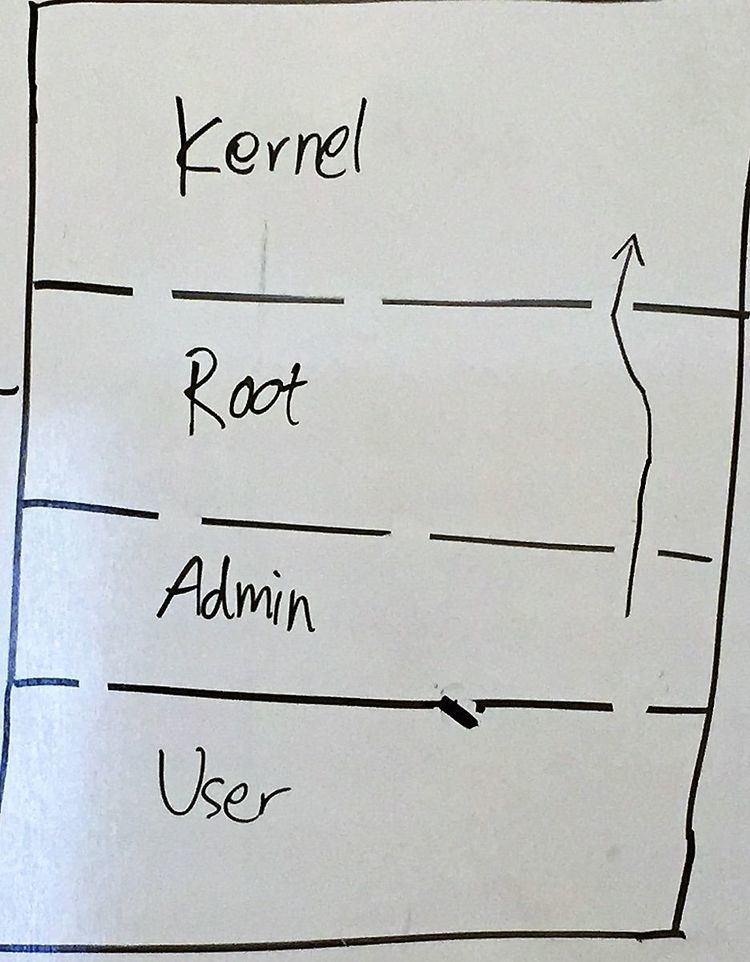 | ||
Privilege escalation is the act of exploiting a bug, design flaw or configuration oversight in an operating system or software application to gain elevated access to resources that are normally protected from an application or user. The result is that an application with more privileges than intended by the application developer or system administrator can perform unauthorized actions.
Contents
Background
Most computer systems are designed for use with multiple users. Privileges mean what a user is permitted to do. Common privileges include viewing and editing files, or modifying system files.
Privilege escalation means a user receives privileges they are not entitled to. These privileges can be used to delete files, view private information, or install unwanted programs such as viruses. It usually occurs when a system has a bug that allows security to be bypassed or, alternatively, has flawed design assumptions about how it will be used. Privilege escalation occurs in two forms:
Vertical
This type of privilege escalation occurs when the user or process is able to obtain a higher level of access than an administrator or system developer intended, possibly by performing kernel-level operations.
Examples
In some cases, a high-privilege application assumes that it will only be provided with input that matches its interface specification, and does not validate the input. An attacker may then be able to exploit this assumption so that unauthorized code is run with the application's privileges:
/etc/cron.d, request that a core dump be performed in case it crashes and then have itself killed by another process. The core dump file would have been placed at the program's current directory, that is, /etc/cron.d, and cron would have treated it as a text file instructing it to run programs on schedule. Because the contents of the file would be under attacker’s control, the attacker would be able to execute any program with root privileges.Jailbreaking
A jailbreak is the act or tool used to perform the act of breaking out of a chroot or jail in UNIX-like operating systems or bypassing digital rights management (DRM). In the former case, it allows the user to see files outside of the filesystem that the administrator intends to make available to the application or user in question. In the context of DRM, this allows the user to run arbitrarily defined code on devices with DRM as well as break out of chroot-like restrictions. The term originated with the iPhone/iOS jailbreaking community and has also been used as a term for PlayStation Portable hacking; these devices have repeatedly been subject to jailbreaks, allowing the execution of arbitrary code, and sometimes have had those jailbreaks disabled by vendor updates.
iOS systems including the iPhone, iPad, and iPod touch have been subject to iOS jailbreaking efforts since they were released, and continuing with each firmware update. iOS jailbreaking tools include the option to install Cydia, a third-party alternative to the App Store, as a way to find and install system tweaks and binaries. To prevent iOS jailbreaking, Apple has made the device boot ROM execute checks for SHSH blobs in order to disallow uploads of custom kernels and prevent software downgrades to earlier, jailbreakable firmwares. In an "untethered" jailbreak, the iBoot environment is changed to execute a boot ROM exploit and allow submission of a patched low level bootloader or hack the kernel to submit the jailbroken kernel after the SHSH check.
A similar method of jailbreaking exists for S60 Platform smartphones, which involves installing softmod-style patches which involves patching certain ROM files while loaded in RAM or edited firmware (similar to the M33 hacked firmware used for the PlayStation Portable) to circumvent restrictions on unsigned code. Nokia has since issued updates to curb unauthorised jailbreaking, in a manner similar to Apple.
In the case of gaming consoles, jailbreaking is often used to execute homebrew games. In 2011, Sony, with assistance from law firm Kilpatrick Stockton, sued 21-year-old George Hotz and associates of the group fail0verflow for jailbreaking the PlayStation 3 (see Sony Computer Entertainment America v. George Hotz and PlayStation Jailbreak).
Mitigation strategies
Operating systems and users can use the following strategies to reduce the risk of privilege escalation:
Horizontal
Horizontal privilege escalation occurs when an application allows the attacker to gain access to resources which normally would have been protected from an application or user. The result is that the application performs actions with the same but different security context than intended by the application developer or system administrator; this is effectively a limited form of privilege escalation (specifically, the unauthorized assumption of the capability of impersonating other users).
Examples
This problem often occurs in web applications. Consider the following example:
This malicious activity may be possible due to common web application weaknesses or vulnerabilities.
Potential web application vulnerabilities or situations that may lead to this condition include:
